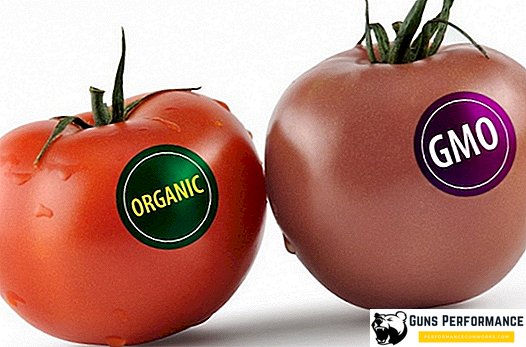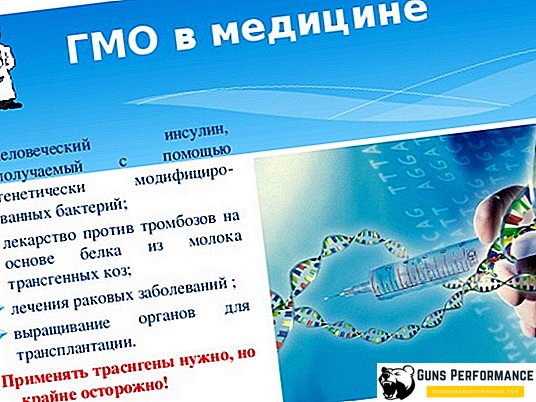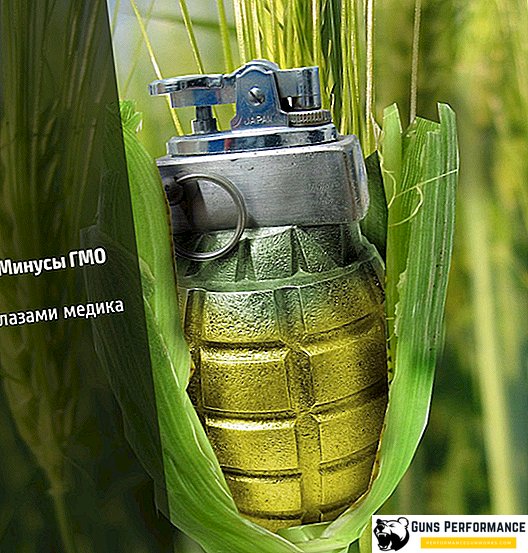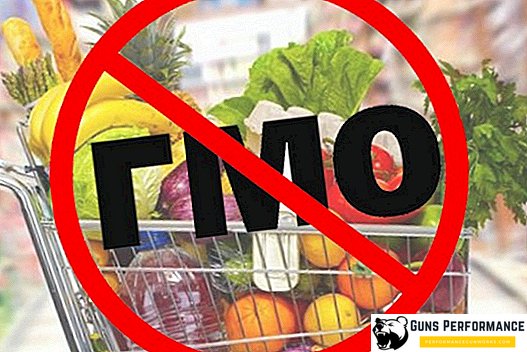Stickers (signs) "Without GMOs" (does not contain GMOs) are now satellites of organic products: together with the "environmental friendliness" of packaging design and competent advertising, they seem to guarantee people healthy prospects. For example, in the United States alone, for the eighth year, tens of thousands of product names have been submitted for certification by manufacturers.
Manufacturers wished to formalize the fact that their food is not genetically modified. Public organizations together with social activists demanded mandatory labeling of genetically modified products.

In Russia, everything related to GMOs is now regulated by law. Thus, the State Duma passed a law that prohibits the cultivation of genetically modified products in the country. According to this document, it is prohibited to use for planting (planting) seeds of plants, in which the genetic program was changed using genetic engineering technologies or in which they contain genetically engineered materials brought in artificially.
What is GMO?
Genetically modified organisms (GMOs) can be plants, animals, or microorganisms whose genotypes have been modified using genetic engineering techniques. The Food and Agriculture Organization of the United Nations (FAO) considers the use of genetic engineering technologies in the creation of transgenic plant species as an integral part of the process of agricultural development. The process of direct transfer of genes that differ in beneficial traits is a natural stage in breeding work with animals or plants. Such technologies expand many possibilities when creating new varieties.
In essence, GMOs are organisms in which genetic materials (DNA) have been artificially modified (added from some other animals). This is done in order to obtain useful characteristics in the original donor organism. For example, calorie, resistance to parasites, diseases, bad weather. Such products have faster maturation, longer storage, increased fecundity, and this ultimately affects the cost of production.
Why do people need GMOs?

With the help of biotechnology, a considerable set of tasks that modern humanity needs can be solved. This may be due to a shortage of food, agricultural land, environmental pollution, changes in climatic conditions, as well as risks of poor harvest.
Positive aspects of GMOs:
- High resistance to diseases and parasites;
- Increased resistance to herbicides, and therefore to weeds;
- High level of nutrition;
- Saturation with vitamins or healthy oils;
- High resistance to drought or frost;
- Unique ability to grow in the most unusual places;
- More attractive appearance;
- They have less pesticide content than in "natural" fruits and vegetables;
- Due to gene modifications, the amount of carbon dioxide in the atmosphere decreases.
For example, scientists from the Salk Institute (United States of America) are planning to develop GM plants, with the help of which more efficient conversion of carbon dioxide from the atmosphere into inert substances such as suberin is possible, which may lead to a decrease in the greenhouse effect.
GMO advantages in medicine

It is not only in agriculture that genetically modified organisms are used. For example, modern medicine also uses GMOs for its needs:
- Participation in the vaccine development process;
- GM bacteria assist in the production of insulin;
- Gene therapy already cures many diseases, is involved in slowing the aging process.
The dangers (cons) of GMOs
Many scientists argue that the use of products with GMOs carries the following main threats:
- The threat to the human body associated with allergic diseases, metabolic disorders, with the emergence of resistance of the human gastric pathogenic microflora to antibiotics, as well as carcinogenic and mutagenic effects;
- The threat to the environment associated with the emergence of growing weeds that are not easy to cope with, pollution of research areas, chemical pollution, reduction of genetic plasma, etc.
- Global risks associated with the activation of critical viruses, as well as economic security.
For example, in Canada, which is one of many central GM-producing countries, similar cases are already recorded. According to local press reports, many Canadian farms have been the victims of the “occupation” of genetically modified “superweeds”, which have arisen due to the unintentional crossing of three types of GMO rapeseed that is resistant to the most diverse herbicides. After all this experimentation, a plant came out, which, according to the statement of the same local press, became more resistant to most agricultural chemicals.

Similar problems may arise in cases where there is a transition of genes responsible for resistance to herbicides from cultivated plant world to other wild plants. In particular, it was noted that when growing transgenic soybeans, genetic mutations in associated plants (weeds) can occur. They, by the way, are transformed and become immune to herbicides.
It does not exclude the possible transfer of genes by which the coding of protein production occurs. And those in turn become toxic to insect pests. Weeds, which are engaged in the production of their own insecticides, acquire a tremendous advantage in the process of combating pests, insects, which are often a natural restrictor of their growth.
How are GMOs made?
To date, at least three areas of genetic engineering are used, which have something in common with typing: copy / paste, censorship and editing.
For example, in some species, the necessary genes for scientists are taken - genes of interest - which are later introduced into experimental plant species.

Thus, the company Syngenta created Golden Rice (R), which included a gene with pro-vitamin "A" of maize. And Monsanto found the herbicide resistant genes, RoundUp, in bacteria. Moreover, the discovery took place on the territory of their enterprise, which produced these herbicides, and introduced them into plants.
Countries denying GMOs
Marking (GMO sign) of GM plants was introduced in the territory of the Australian Union, China, Israel, Brazil, as well as in individual countries of the European Union. While Canada, the United States, Argentina, and South Africa mark GM products are left on the conscience of manufacturers. But the palm of priority in biotechnological plant growing on the European continent remains up to the present time behind Spain.
Bans on the production of GMOs in Russia
In Russia, GMO production is currently prohibited. However, the importation of food with the content of genetically modified components is authorized. Mainly, modified soybeans, corn, GMO potatoes, and beets, and from the United States, are imported into Russia. The US holds a palm in the production and consumption of GMO products. According to some reports, approximately 80% of US food products contain GMOs.
The National Association for Genetic Safety provided some interesting information. It turns out that the Russian food market includes about 30-40% of food with GMO content. In the past three years, associations have been able to detect GMOs in products of well-known companies, for example, those that produce ready-made breakfasts.
On the territory of our country, not so long ago, we were able to confirm the significant negative effect of the influence of genetically modified organisms on the biological and physiological indicators of some animals. So, the specialists of the already mentioned OAGH presented the results of one of several independent studies on the effect of feed with the content of GMO components, the same GMO potatoes on these indicators in some animals. According to the results of research conducted by the OAGH together with the Institute for the Study of Ecology and Evolution in 2008–2010, it became known that there was a significant negative impact on GM-containing feed, which affected reproductive functions and the health of experimental mammals. There are versions that prolonged use of transgenic soybeans leads to disruption of human and animal health.
Animals receiving GMO feeds, showed a clear backwardness in their development and growth. They were found to have irregularities in the sex ratio in their broods. And there was an increase in the number of female individuals. Moreover, the total number of offspring has decreased, and in the future there was a complete extinction in the second generation. In addition, reproductive abilities in males were also significantly reduced.
According to the opinion and statements of specialists, there are risks that from these products there may be violations of whole food chains. As a result, some species may even disappear in separate ecological systems.

In what products can be GMO composition?
In the market of genetically modified products can be found:
- Soy in its various forms (such as beans, sprouts, concentrates, flour, milk, etc.);
- Maize corn, which can be in different forms (such as flour, cereals, popcorn, butter, chips, starch, syrups, etc.);
- GMO-potatoes in its various forms (such as semi-finished products, dry mashed potatoes, chips, crackers, flour, etc.);
- Tomatoes in their various forms (such as pasta, mashed potatoes, sauces, ketchups, tomatoes with a foreign gene, etc.);
- Squashes, as well as products made with their use;
- Sugar beet, table beet, sugar, produced from sugar beet;
- Wheat, as well as products made with its use, including bread with bakery products;
- Sunflower oil;
- Rice, its containing products (such as flour, granules, flakes, chips);
- Carrots and products with its content;
- Varieties of bulb onion, shallot, leek and other bulbous vegetables.

Accordingly, there is a high probability of encountering GMOs in products that are produced using these plants. Mainly genetic modification is subjected to soybeans, canola, corn, sunflower, GMO potatoes, strawberries, tomatoes, zucchini, paprika, as well as lettuce. Even baby food contains GMO products. And all this can be bought at a regular supermarket.
The sensational prophecies of Jules Verne
In 1994, the great-grandson of a famous science fiction writer in the process of working with family archives was lucky to discover one of the previously unpublished novels of Jules Verne. It was a novel called "Paris in the XX century". The action took place in Paris XX century, which was illuminated advertising, televisions, cars with internal combustion engines.
What is most interesting in this work was the prediction of a single discovery. These were the so-called "living atoms" responsible for heredity in plants and living organisms. Moreover, the science fiction writer was able to somehow learn about gene crossing. He predicted that plants will be created (following the example of tomatoes), which will develop the ability in all weather conditions, even in frosts, to bring more than one crop per year. In accordance with the idea of Jules Verne, with the help of such artificially created plants, mankind will be able to overcome hunger, and universal abundance will be achieved.
However, not all was so rosy in these prophecies. A little later, decades later, mankind will find that such products will prove to be extremely dangerous to human health. Moreover, the consumption of such products will cause one terrible disease - "sudden old age."
And how often it happens “purely by chance”, when the discovered novel was to be published (it was almost ready for printing), the first transgenic products appeared in the trade network, and these were tomatoes. At that time, scientists for the first time made changes to the genetic structure of plants. The publication of a science fiction novel could in many respects affect the reputation of products containing GMOs, so it was published in a slightly reduced form. Naturally, information on the effects of GMOs on a living organism, on humans and the dangers of using GMO products has been classified. Today it becomes clear that such a prophecy enters the life of the people. Only a little remains: wait a few more decades to make sure it is true.
Instead of conclusion

In light of the foregoing, brief conclusions can be made. GMO products can be beneficial only to manufacturers who earn super profits. The GMO products, besides the economic component for their manufacturers, do not bear the obvious benefit to people. However, as well as one hundred percent to prove the damage is not yet possible, at least in the present world order. Such is the story and the problem of GMOs. Each person will have to decide for himself what kind of food he will eat and whether he and his whole family will use this poison.












